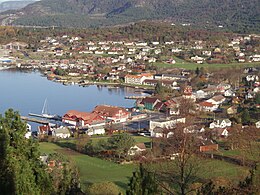Stord (island)

View of the village of Fitjar
|
|

Location in Hordaland county
|
|
| Geography | |
|---|---|
| Location | Hordaland, Norway |
| Coordinates | 59°53′N 5°25′E / 59.883°N 5.417°ECoordinates: 59°53′N 5°25′E / 59.883°N 5.417°E |
| Area | 241 km2 (93 sq mi) |
| Highest elevation | 749 m (2,457 ft) |
| Highest point | Mehammarsåto |
| Administration | |
|
Norway
|
|
| County | Hordaland |
| Municipalities | Stord, Fitjar |
| Demographics | |
| Population | 19,400 |
| Pop. density | 80.49 /km2 (208.47 /sq mi) |
Stord is an island in Hordaland county, Norway. Located in the traditional district of Sunnhordland, the island is part of the municipalities of Stord (southern part) and Fitjar (northern part). The largest settlements on the island are the town of Leirvik (granted town status in 1997) and the villages of Sagvåg and Fitjar.
Stord has an area of 241.2 square kilometres (93.1 sq mi) and the highest point is the 749-metre (2,457 ft) tall mountain Mehammarsåto. The island lies on the northern side of the mouth of the great Hardangerfjorden. The Selbjørnsfjorden lies on the north end of the island. On the east side of the island, the Langenuen strait separates Stord from the neighboring island of Tysnesøya. On the west side of the island, the Stokksundet strait separates Stord from the neighboring island of Bømlo. There are over 350 small islands and skerries lying off the northeastern coast. Most of the central part of the island is mountainous, leaving the islands population living mostly along the coasts. The vast majority of the population lives on the southern coastal area near the Hardangerfjorden.
The mountains on Stord contain a lot of pyrite. There was a pyrite mine at Litlabø until 1968. At Vikanes, there are marble quarries. Huglo has limestone quarries that have been an important source of extra income since the 1500s. Beyond the lowlands, along a line from Sagvåg in the southwest to Jektevik in the northeast, rises a mountainous ridge with peaks of over 700 metres (2,300 ft). The highest of which is the 749-metre (2,457 ft) tall mountain Mehammarsåto furthest to the north. In this mountainous area, the rock varies from basalt lava, gabbro, and granite.
...
Wikipedia
